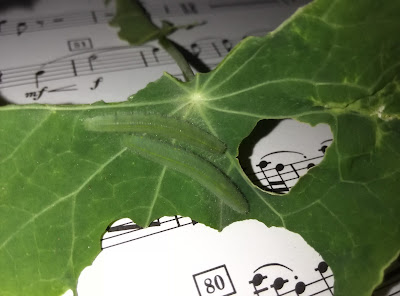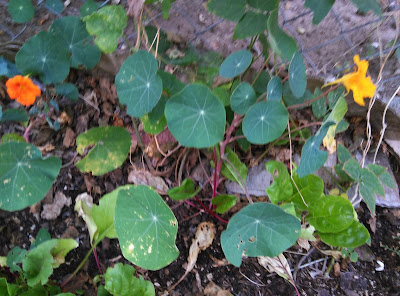In the photo below, you can see how this works. Two well-camouflaged green worms appear to be relaxing on the nasturtium leaf at upper left, possibly dreaming of the day they will morph into white moths. Meanwhile the tomato leaf at upper right remains untouched.
Though it shows oregano, tarragon, and marjoram to good advantage, I do not like this photo. The sun was so bright that all I could see on the screen of my smart phone was my own reflection. I showed the worms and the photo to Steve, and he wisely offered a solution: "Why don't you take off the leaf?" Why, indeed? So I carried the leaf and its little sunbathers inside and placed them on a piece of band music. What a lovely setting:
After snapping this photo, I gently placed the nasturtium leaf, worm-side down, in a compost digester. A couple of hours later, the worms had vanished while the leaf was virtually unchanged.
Though I often choose a politically correct option when facing a moral dilemma, I feel no guilt about harboring nasturtiums. I have repented my old way of letting them run rampant, but I have have never believed that, in the context of my urban, self-contained garden, they would "fuel wildfires, degrade grazing land, contribute to soil erosion, clog streams and rivers, and increase the risk of flooding." Even so, I keep an eye on them. A good way to see a flower or two.
This photo, taken earlier this morning before the sun hit this part of the garden, shows at least two nasturtiums keeping watch over some small Swiss chard. Unfortunately in this case the pests seem to prefer the chard.




2 comments:
Nothing as profound or clever as your post, Frances, but I did read every word and thoroughly enjoyed them all. I especially like your leaf photo over the band music. - ATP in Los Altos
Thanks, ATP. Now I'm wondering, would the worms have started singing at measure 80 if I hadn't interrupted them? Maybe I'll try it again.
Post a Comment